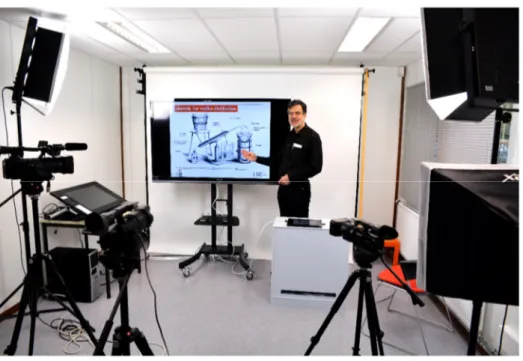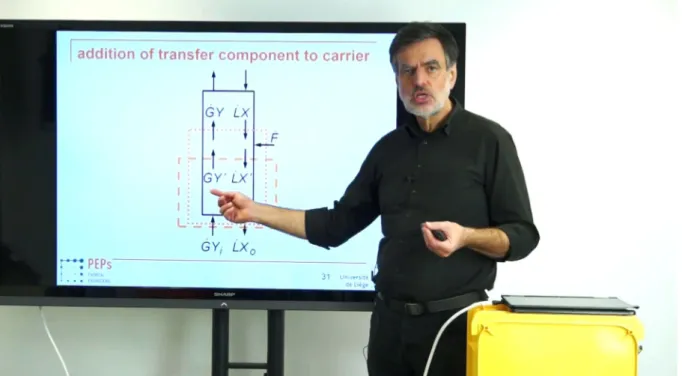Tutorial Videos on Solvent Extraction
Texte intégral
(2) ISEC 2017 - The 21st International Solvent Extraction Conference. the PowerPoint slides significantly looses contrast because of the bright lighting. In case the presenting person is not properly lit, the facial expression cannot be recognized or there are too strong shadows in the face. Also in some situations the picture of the projector turned out to be too bright, so that details of the diagrams were lost in the video recording. Thus, no lighting situation using an ordinary projector led to acceptable results. It was then proposed to use greenscreen technology. This has actually not been tested, because the lecturer is no professional actor used to such technology, but the proposal led to formulate the detailed goals for a good video recording. These requirements were defined as: • the person delivering should be clearly visible also with his/her facial expression and should be able to interact with the projected slides while explaining their content, because this would facilitate a vivid presentation of the lecture content, • the diagrams shown should be sufficiently rich in contrast in order to realize enough detail, where this actually also sets up boundary conditions for the slides presented, • when writing notes, e.g. during derivations, the text written should always be clearly visible to enhance that students can follow the content, and • the sound recording should be of sufficient quality, especially to allow maximizing recording level without decreasing the signal-to-noise ratio. To reach these goals especially different lighting setups have been tested. Optimal quality was finally reached by using a large TV screen for projecting the presentation slides and to use a tablet or convertible with a suitable writing program for presenting the derivations. This is shown exemplarily in Figure 1. This way also a direct interaction between presenter and presentation is apparently easily possible and derivations can be recorded from the same TV screen. Sound recording is performed with a condenser microphone and a recording device which allows wav-recording with 24-bit resolution.. Figure 1. Recording environment (photo by: Olivier Borsu, IFRES (Institut de Formation et de Recherche en Enseignement Supérieur), Université de Liège). - 29 -.
(3) ISEC 2017 - The 21st International Solvent Extraction Conference. With this setup a series of videos is currently being recorded, which starts out with the basics of thermal unit operations, which will also include extraction, phase separation, etc. In the meantime already the basic design principles have been made available on YouTube [1], e.g. including a generalized McCabe-Thiele method. An example screen from a video is shown in Figure 2, which shows that many of the requirements are very well fulfilled with this setup. The screen of the convertible laptop can be switched with the push of a button between the presentation and a journal file used for the manual derivations. The sound is recorded separately with a Roland Edirol R-09 with 24 bit resolution. It turns out that such a recording environment, which at the University of Liège is kindly supplied by the Training and Research Institute for Higher Education (IFRES), can be obtained including a suitable convertible laptop with a comparably low budget of well below 10 000 Euro. IFRES meanwhile is using this optimal setup for other video recordings as well.. Figure 2. Resulting screen of a video After the raw recording the video is cut with an available software. The soundtrack from the Edirol is added after preliminary steps performed with the open-source software audacity [2], which include normalization, level adjustment and slight compression. The videos are then produced in high quality and uploaded to YouTube. This is an ongoing project. At the start the first lectures from the lecture ‘Thermal Spearation Processes’ have been recorded, which begins with topics of distillation. As a second large chapter general considerations have been collected, which include among others a very fundamental description of the McCabe-Thiele method in a way that it can be applied to essentially all counter-current separation processes. Special emphasis is placed on the systematic derivations, which include a thorough discussion of the assumptions. It should be mentioned that this has already been. - 30 -.
(4) ISEC 2017 - The 21st International Solvent Extraction Conference. very valuable in an industry cooperation, where in industrial practice overall mass flowrates and mass ratios (loads) had been used to determine the number of theoretical stages of a real equipment, which led to surprising results. This combination unfortunately does not comply with the assumptions made in deriving the McCabe-Thiele method. Only after the appropriate basis had been chosen and systematically applied, i.e. the mass ratios were combined with the flowrates of the carrier components, i.e. water and an organic solvent, correct and meaningful values were obtained. The strong difference in this case was a result of the high load of the transfer component transferred between the pahses. It has also been realized that in the research group several excellent presentations on advanced topics have been prepared in the past and delivered on various occasions including expert workshops. Also very basic knowledge, e.g. on the influence of electrolytes on interaction of interfaces thus strongly influencing coalescence or on the origin and behavior of mass-transfer induced instabilities has been collected over the last years. This knowledge is dispersed over a variety of scientific publications. The nature of such publications does not allow proper didactic presentation of the findings. Correspondingly this knowledge is hard to access for the novice. Thus the final goal of this project is to collect in the videos all expertise acquired in the research group, e.g. on extractant selection, coalescence and phase separation, including design of reactive steps. This effort is supported by supplying the lecture manuscripts as PDF file on our website [3]. This way a collection of easily accessible and complete teaching and advanced-training material will be made available in the future. The level of the presentations is on the one hand side basic, i.e. the goal is that every novice can follow. This includes detailed derivations of a variety of aspects, since it is believed that for a proper university education, where the students are educated to be able to cope with new situations, also the full background of the fundamental cases needs to be delivered. On the other hand significant detail is supplied, which is relevant for the advanced scholar and expert. Currently large effort is put into obtaining picture and graphical material for utilization in the videos taking the copyright issues appropriately into account. From a variety of companies e.g. photographs of their internals have been obtained. These new diagrams will be used to substitute those which have until now been presented in the lectures, which were collected from the internet and textbooks. This will simultaneously significantly enhance the quality of the presentations. Finally it should be mentioned that meanwhile the first of these videos have been synchronized in Brazilian Portuguese. 3. Invitation Since in a university environment e.g. large-scale equipment as well as a variety of practical issues like trouble-shooting cannot be properly addressed, the author invites other experts in the field to contribute, e.g. by contributing videos, which can be recorded in our studio. Also it turns out that it is significant effort to obtain photos and videos of large-scale equipment and test facilities. While all companies addressed so far were quite supportive, nevertheless for each individual photo, diagram, video, etc. the copyright issues need to be addressed. Here also support from companies with respect to real-world photos, graphs, and videos is very welcome. Of course appropriate credits will be given.. - 31 -.
(5) ISEC 2017 - The 21st International Solvent Extraction Conference. Since also problematic cases with e.g. corroded examples would be welcome, confidential treatment of the source can be ensured as well. Of course everybody is also invited to watch the videos, which are published under the creative-commons license by-nc-sa, i.e. attribution, non-commercial, and share alike. As mentioned, in the future the content will grow and increasingly also include expert topics. 4. Conclusion After more than 25 videos of mostly between 20 and 45 minutes length have been produced, it can be concluded that this approach is quite feasible. The video recording and production is admittedly some effort. From experience it can be said that every video is generally recorded twice, since during the first recording the small inefficiencies in the manuscript and the slides become obvious, which apparently cannot be avoided even with very careful preparation. These inefficiencies are then removed for the second recording. Thus as a consequence it is found that also the material used, i.e. the PowerPoint slides as well as the manuscript are significantly enhanced by the video recording.. 1) 2) 3). References A. Pfennig, Thermal Unit Operations. YouTube Playlist (2017) https://www.youtube.com/playlist?list=PLEivQtB6FVkfUbs81p-i42FtjEl_2NWZY audacity, https://sourceforge.net/projects/audacity/ http://chemeng.ulg.ac.be/PUO1. - 32 -.
(6)
Figure


Documents relatifs
Thus, decreasing solvent polarity also reduces water-crown complexation [L‚H 2 O (org) ], leading to lower k values. This is probably caused by the combination of a lower solubility
To study the effect of the aqueous pH on the IL constituent ions solubility and HBTA deprotonation, their individual concentrations were measured as a function
In a given contention period mini-slot, a node wanting to access the channel will transmit a RTS with 3 possible pre- computed probabilities if and only if one of the following these
By using the evolutionary methodology USPEX for crystal structure prediction, we have extensively explored the potentially stable structures of Moσ 2 in the
Cette question ne semble pas ˆ etre ´ etudi´ ee dans la litt´ erature alors que plusieurs travaux traitent du cas o` u les deux variables sont censur´ ees ` a droite.. La m´
This demonstrates that, in addition to its possible appearance as an electronic instability, it may also appear as a structural anharmonic improper mode within the Pbnm phase
This interna- tional study, based on an outstanding series of 1,694 unrelated patients with PCC or paraganglioma (PGL), has been able to ascertain the prevalence of MAX muta- tions
hémodynamique et lorsqu’ elle a dû «arranger le patient et le diriger vers la morgue ». Diane explique difficilement les sentiments qu’elle éprouve à ce moment précis: «on